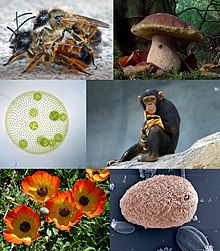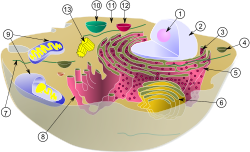
Back Eukarioot Afrikaans Eukaryoten ALS Eukaryota AN حقيقيات النوى Arabic حقيقيات النوى ARZ সংকোষকেন্দ্ৰীয় জীৱ Assamese Eukaryota AST Eukariotlar Azerbaijani Эукариоттар Bashkir Eukaryota BAN
| Eukaryota | |
|---|---|

| |
| The pictures above show Eukaryotes – clockwise from top left: Red mason bee, Boletus edulis, Common chimpanzee, Isotricha intestinalis, Persian buttercup, and Volvox carteri | |
| Scientific classification | |
| Domain: | Eukaryota (Chatton, 1925) Whittaker & Margulis, 1978 |
| Supergroups[2] and kingdoms | |
Eukaryotic organisms that cannot be classified under the kingdoms Plantae, Animalia or Fungi are sometimes grouped in the kingdom Protista. | |

An eukaryote is an organism with complex cells, or a single cell with complex structures. In these cells the genetic material is organized into chromosomes in the cell nucleus.
Animals, plants, algae and fungi are all eukaryotes. There are also eukaryotes amongst single-celled protists.
In contrast, simpler organisms, such as bacteria and archaea, do not have nuclei and other complex cell structures. Such organisms are called prokaryotes.
Eukaryotes evolved in the Proterozoic eon. The oldest known eukaryote is Grypania, a coiled, unbranched filament up to 30 mm long.[3] The oldest Grypania fossils come from an iron mine near Negaunee, Michigan. The fossils are dated as 1874 million years old.[4][5] Grypania lasted into the Mesoproterozoic era.
Another ancient group is the acritarchs, believed to be stages of algal plankton. They are found 1400 million years ago, in the Mesoproterozoic era.[6]p57
The classification of the Eukaryota is under active discussion, and several taxonomies have been proposed. Modern versions disagree about the number of kingdoms.[7]
- ↑ Sakaguchi M, Takishita K, Matsumoto T, Hashimoto T, Inagaki Y (July 2009). "Tracing back EFL gene evolution in the cryptomonads-haptophytes assemblage: separate origins of EFL genes in haptophytes, photosynthetic cryptomonads, and goniomonads". Gene. 441 (1–2): 126–31. doi:10.1016/j.gene.2008.05.010. PMID 18585873.
- ↑ Adl SM, Simpson AG, Lane CE, Lukeš J, Bass D, Bowser SS, et al. (September 2012). "The revised classification of eukaryotes" (PDF). The Journal of Eukaryotic Microbiology. 59 (5): 429–93. doi:10.1111/j.1550-7408.2012.00644.x. PMC 3483872. PMID 23020233. Archived from the original (PDF) on 16 June 2016.
- ↑ Knoll, Andrew H. et al 2006. Eukaryotic organisms in Proterozoic oceans. Philosophical Transactions of the Royal Society B 361 (1470): 1023–38. [1]
- ↑ Schneider D.A. et al 2006. Age constraints for Paleoproterozoic glaciation in the Lake Superior Region: detrital zircon and hydrothermal xenotime ages for the Chocolay Group, Marquette Range Supergroup. Canadian Journal of Earth Sciences 43, 571-591. [2]
- ↑ Han T.M. & Runnegar B. 1992. Megascopic eukaryotic algae from the 2.1-billion-year-old negaunee iron-formation, Michigan. Science 257 (5067): 232–235. [3]
- ↑ Clarkson E.N.K. 1998. Invertebrate palaeontology and evolution. Blackwell, Oxford.
- ↑ Luketa, Stefan (2012). "New views on the megaclassification of life". Protistology. 7 (4): 218–237. ISSN 1680-0826.